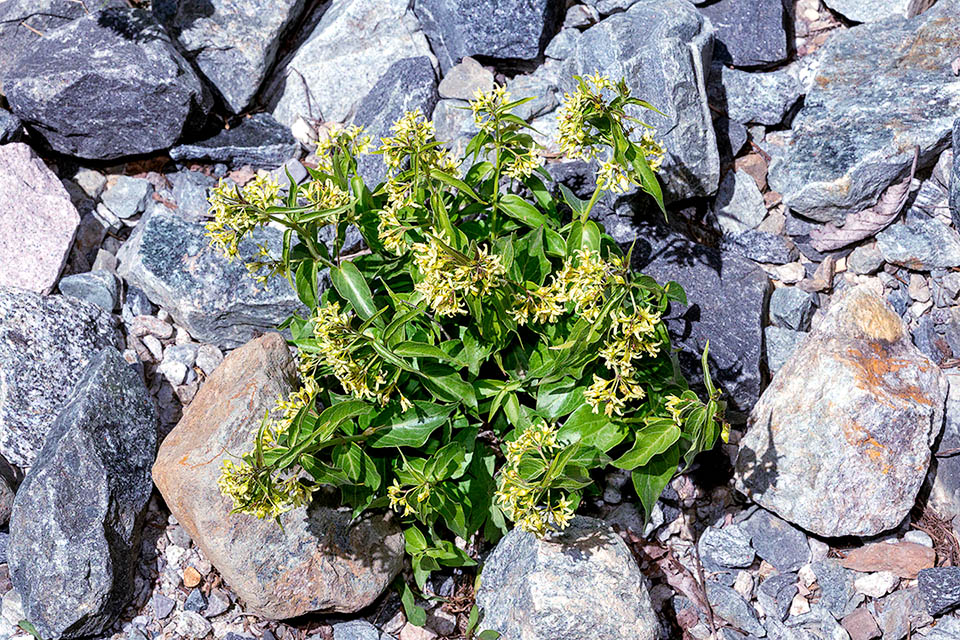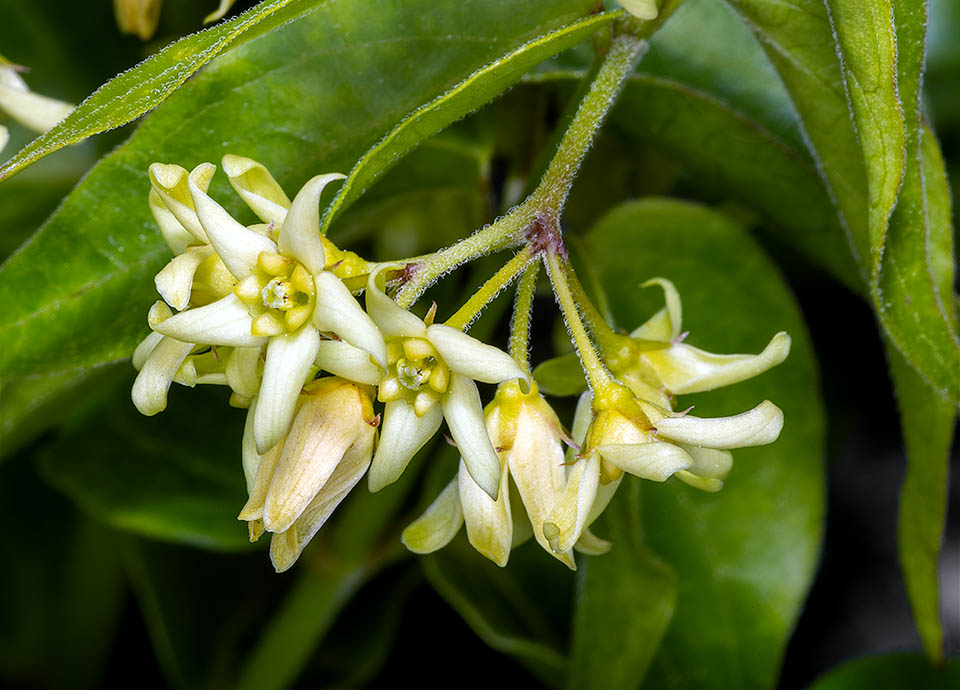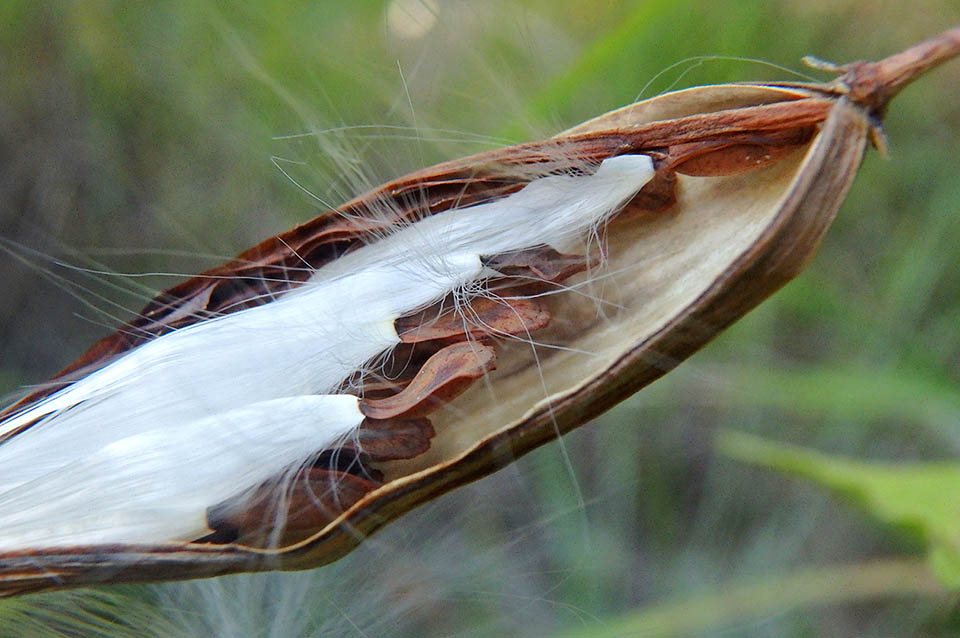Family : Apocynaceae

Text © Prof. Salvatore Cambria

English translation by Mario Beltramini

Introduced in North America, Vincetoxicum hirundinaria is native to continental Eurasia, from Europe Atlantic coasts to Russia and Japan, and on north African reliefs © Giuseppe Mazza
Vincetoxicum hirundinaria is a species belonging to the family of the Apocynaceae, described by the German Botanist and physicist Friedrich Kasilir Medikus (1736-1808) in his work “Historia et Commentationes Academiae Electoralis Scientiarum et Elegantiorum Litterarum Theodoro-Palatinae, Mannheim”, published in 1790.
The genus Vincetoxicum comes from the Latin verb “vinco”, I win, and from “toxicum”, poison and therefore literally means “wins the poison” with reference to the use of the species of this genus as emetics in the treatment of poisonings.
The specific epithet hirundinaria derives from “hirundo” swallow, referring to the swallowtail shape of the mature follicle or less probably of the root.

Flowers appear from June to late July. They are pedunculate and merged in corymbose cymes at the leaves axil © Giuseppe Mazza
The species is known with various common names in the different zones of its range. For instance, in Germany it is known as “Schwalbenwurz”, “Dompte-venin officinal” in French, “Vincetossico comune” in Italian, “White swallow-wort” in English and “Vencetósigo” in Spanish.
It is a perennial herbaceous plant up to 1 m tall, equipped with a creeping rhizome.
The stems are erect, streaked, with two rows of hairs, at times slightly twisted, lignified at the base.
The leaves have a short petiole, opposite, lanceolate with sharp apex, being the upper pagina of dark green colour, the lower one, reticulate, of a paler green colour.
The flowers appear from June to late July and are pedunculated and merged in corymbose cymes at the axil of the leaves.
The calyx has 5 linear sepals, fused together and acuminate at the apex. The corolla is cream-white with 5 spaced lobes, but partially fused, by a membrane 1/2 of their length. The stamens are yellow-greenish. The pollination is entomogamous.
The fruits are fusiform follicles on reflexed peduncles up to about 5 cm long, with several ovoid seeds, compressed, winged, brownish, feathery by white hairs and therefore easily dispersed by the wind.
From an ecological point of view, this species loves cliffs, arid slopes, especially on substrata of calcareous nature, but is sometimes found also in thin woods and open shrubs, from the sea level up to 1700 m.
Its native range includes vast areas of continental Eurasia from the Atlantic coasts of Europe up to Russia and Japan. Moreover, it is present in the reliefs of North Africa and some introduced populations are present in North America (Ontario, Michigan and New York).
Vincetoxicum hirundinaria is often absent in insular environments, in fact it’s missing in Great Britain and in the United Kingdom and in most of the islands of Mediterranean. The species presents a remarkable morphological variability that has led to the description of several subspecies (about 10-11), whose rank is not always accepted by all Authors. In Italy the presence of four subspecies is recognized. As a matter of fact, in addition to the typical subspecies, are present Vincetoxicum hirundinaria subsp. contiguum (W.D.J.Koch) Markgr., Vincetoxicum hirundinaria subsp. laxum (Bartl.) Poldini and Vincetoxicum hirundinaria subsp. luteolum (Jord. & Fourr.) La Valva, Moraldo & Caputo.

Calyx has 5 linear sepals, merged and sharp at the apex. Corolla is white-cream with 5 lobes spaced but partially united by a membrane. The stamens are yellow-greenish and pollination is entomogamous. All plant’s parts are poisonous, but once it was used against the bites of snakes and for alleged medicinal virtues © Giuseppe Mazza
From an ethnobotanical point of view, Vincetoxicum hirundinaria is a poisonous plant traditionally utilized in the treatment of diseases and in magical practices.
In fact, in popular medicine it was used as an antidote against snake bites and for its presumed diuretic, depurative and sudorific properties.
The plant is mentioned by Dioscorides as a traditional plant utilized by Dacians and known as “herb of animals”, that it was thought to open any locked door. The main chemical compounds present in this species are various glycosides, vincetoxin, vinvetoxicosides A and B, alkaloids, whilst only in the seeds is present a cardiologically active ingredient.

The fruit is an even 5 cm long fusiform follicle, with several ovoid seeds brownish and compressed with white feathery hairs that scatter them in the wind © Krylenko VV
The vincetoxin has an action similar to that of the aconitine and causes abundant salivation, vomiting, diarrhea, intestinal pain, cramps and paralysis.
The species has a strict relation with a fungus called Cronartium flaccidum (Alb. et Schw.) Wint. agent of the vesicular rust of the bark of the two-needle pines, that for completing its vital cycle, uses the Vincetoxicum as intermediate host.
Synonyms: Asclepias vincetoxicum L. (1753), Asclepias alba Lam. (1779), Vincetoxicum officinale Moench (1794), Asclepias toxicaria Salisb. (1794), Cynanchum vincetoxicum Pers. (1805), Vincetoxicum ochroleucum Jord. & Fourr. (1866), Antitoxicum laxum (Bartl.) Pobed (1952), Antitoxicum officinale Pobed (1973).
→ To appreciate the biodiversity within the APOCYNACEAE family please click here.
